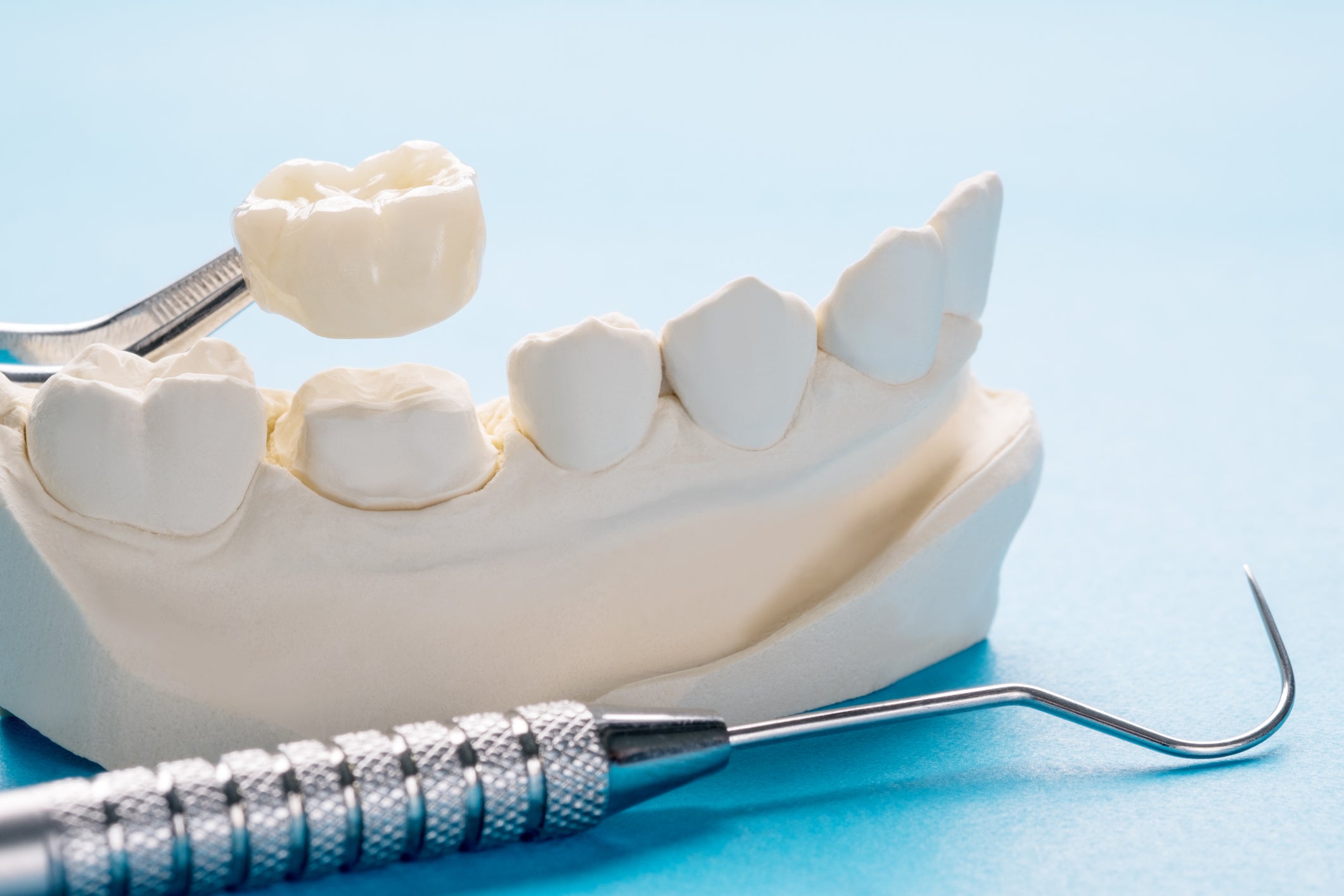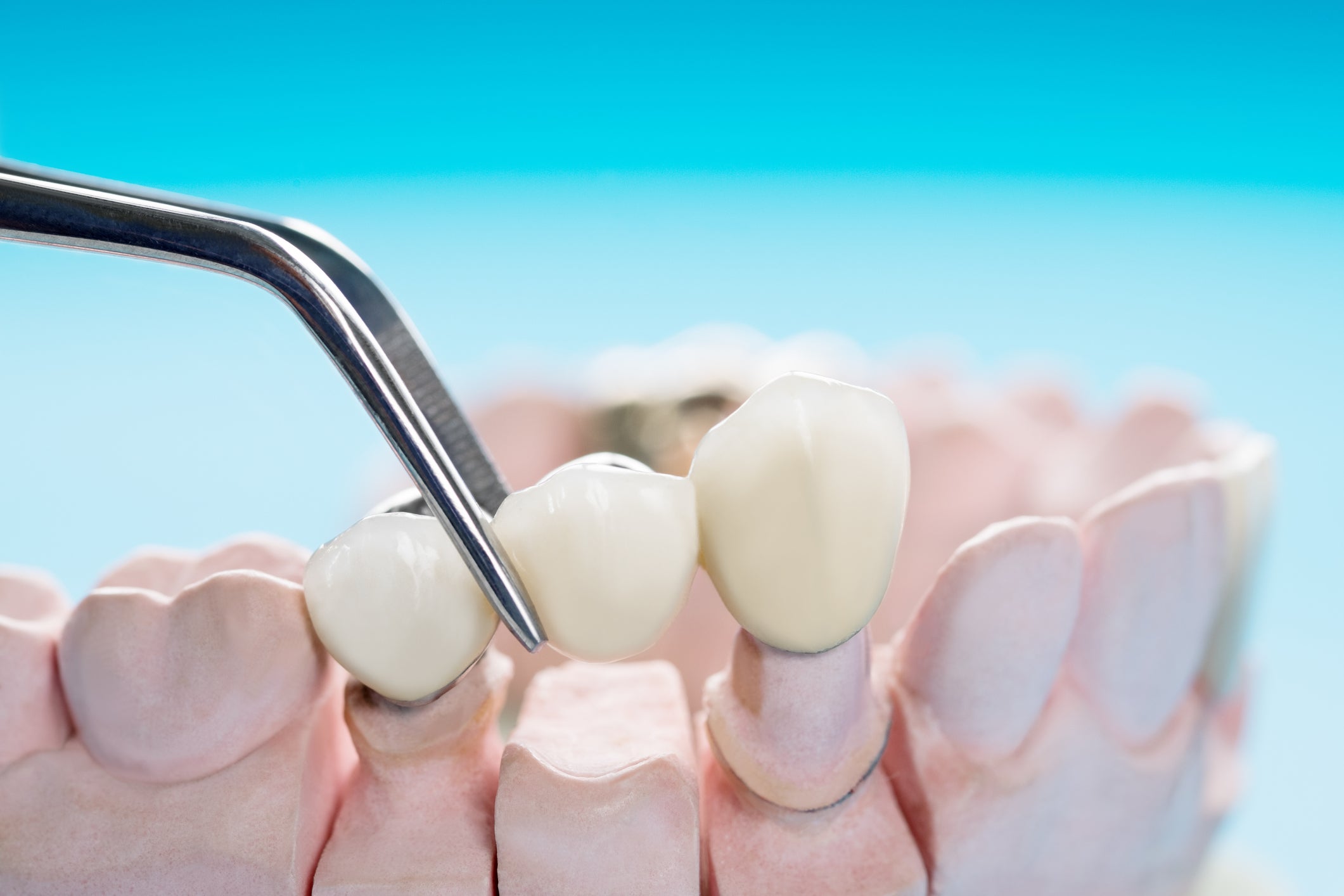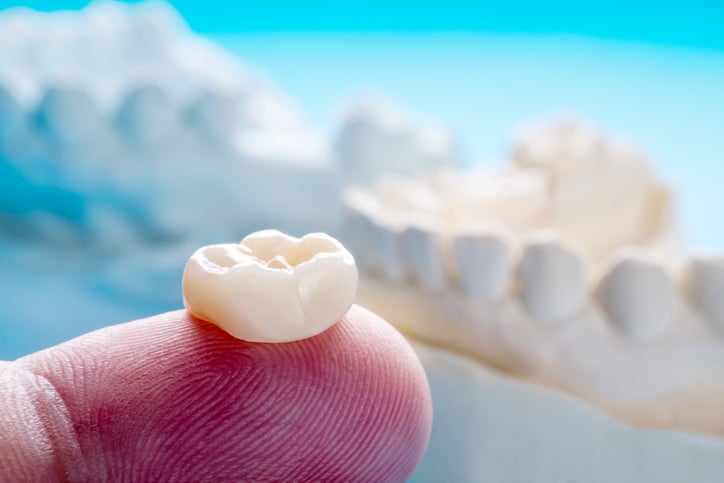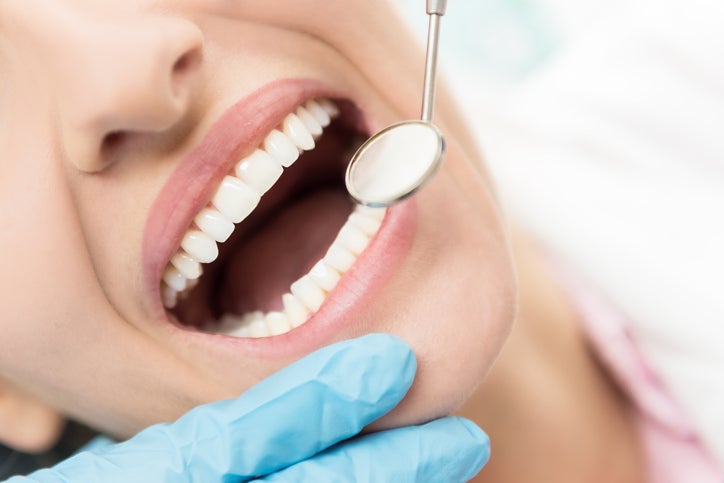-
What Are Crowns and When Do You Need Them?

Dental Crown.
So, your dentist has just told you that you need a crown, and you’re flattered! You didn’t expect to be treated like royalty, and yet, it’s all about to happen. You eagerly await your coronation. Though we hate to interrupt this flight of fancy, we have some bad news for you: it’s not that kind of crown. A crown is actually a cap for damaged teeth, and if your dentist is telling you that you need one, it means you have a tooth problem.
Why would someone need a crown, anyway? It could be that you have a cavity to large for a filling. It might also be that you have a tooth that’s worn down, cracked, or weak, and needs a crown to protect it. Similarly, if you’ve had a root canal, your fragile tooth may need the protection of a crown. If you need a dental bridge or implant, you may also need a crown.
There are different types of crowns, made of a variety of materials. Your dentist will discuss your options with you, and you’ll need to consider several factors, like the cost, strength, and durability, as well as where the crown will sit in your mouth. Generally, there are four different materials from which to choose when deciding on a crown.
- Ceramic crowns, which are actually made of a porcelain-based material, are typically used for front teeth, because they blend with the natural color of your teeth.
- Crowns made of porcelain fused to metal are extremely durable.
- Gold alloy crowns, made of gold, copper, and other metals, bond well to the tooth and don’t fracture or wear away the tooth.
- Base metal alloy crowns, made of non-noble metals, are very strong and resistant to corrosion.
In addition to the materials from which they’re made, crowns come in a variety of types. Sometimes, your dentist will place a temporary crown in your mouth while you’re waiting for a permanent crown, which you will get at a second appointment. In other cases, a crown can be placed in a single appointment, if your dentist offers computer-aided design and manufacturing. Some crowns don’t cover the whole tooth. These are called onlay or ¾ crowns. Your dentist can let you know what type of crown you need and how many appointments will be required.
Getting a crown is not typically painful. You will be given a local anesthetic, after which your dentist will get the tooth ready for the crown by removing some enamel, as well as any decay or filling material. The goal is to start with a healthy tooth structure on which the crown can be built. An impression or intraoral 3D scan is made, so that the crown will fit perfectly. Then the dentist places either the temporary or permanent crown, depending on what’s required. Once you have your new crown, take care of it by brushing, flossing, and refraining from eating hard foods like ice, which could break your crown. Crowns typically last seven to 15 years, but with careful maintenance, they can last much longer.
If you need a crown, make an appointment with the dentist voted best in New York. At Park 56 Dental Group, we offer pediatric, prosthodontics, endodontics, oral surgery, Invisalign®, emergency, and sedation dentistry, all at the highest level of treatment. We serve the Midtown, Central Park, Upper East Side, Park Avenue, and all surrounding Manhattan and New York areas, with a patient-centered practice that has hours to fit your schedule. Schedule your complimentary consultation today by contacting us online or calling us at (212) 826-2322.
-
Celebrities Who Have Had Cosmetic Dentistry Procedures

The first stanza of a poem by Phyllis McGinley, called “Reflections Dental” reads:
How pure, how beautiful, how fine
Do teeth on television shine!
No flutist flutes, no dancer twirls
But comes equipped with matching pearls.
Gleeful announcers all are born
With sets like rows of hybrid corn.Have you noticed that every celebrity seems to have perfect teeth? Are they born that way? Actually, many celebrities choose cosmetic dentistry procedures to make them look more perfect. Did you suspect the stars on this list of improving their pearly whites?
- Tom Cruise: His winning smile is the result of whitening, straightening, and an upgrade to porcelain veneers.
- George Clooney: Although his smile was always gorgeous, his history of tooth grinding shortened his teeth until they were lengthened with veneers
- Gary Busey: Speaking of having teeth lengthened, Gary Busey opted for outsized veneers after an accident.
- Mike Tyson: He had a gold tooth and a gap, but then he had the gap narrowed and traded in the gold for veneers. Surprisingly, because it was his signature look, he had the gap added back!
- Hillary Duff: After chipping a tooth on a microphone during a show, she decided to get a full set of veneers instead of a single repair.
- Ben Affleck: He used to have an overbite, but after lengthening, porcelain veneers, crowns, and whitening, he’s got a dazzling smile.
- Victoria Beckham: Posh Spice’s teeth used to be less than posh, but she’s had them fixed with a set of veneers.
- Jim Carrey: He once had a broken tooth capped, and he removed that cap for his snaggle-toothed Dumb and Dumber smile. Since then, he’s gone for veneers.
- Morgan Freeman: He was successful when he had gapped teeth, but in recent years he’s gotten whitening and used veneers to straighten his teeth.
- Miley Cyrus: The slightly crooked teeth of this child smile were replaced with veneers once she grew up.
- Catherine Zeta-Jones: Teased as a child over crooked teeth, she fixed her alignment with orthodontics and upgraded her smile with veneers.
- Chris Rock: The success of Lethal Weapon allowed him to spend $150,000 on a new smile!
- Zac Efron: His charming gap-toothed grin has been replaced with the perfection of veneers, but he wore false teeth to play Bundy.
- Nicolas Cage: He had two teeth pulled for the 1984 film “Birdy” but has since gotten a full set of veneers.
- 50 Cent: Shot in the face in 2000, he lost a tooth a gained a gap. He later fixed his teeth with whitening and veneers.
Do any of these names surprise you? Here’s some good news: the same procedures used by celebrities are available for you. At Park 56 Dental Group, we offer dental care, including smile restoration, providing the highest level of treatment. We serve the Midtown, Central Park, Upper East Side, Park Avenue, and all surrounding Manhattan and New York areas, with a patient-centered practice that has hours to fit your schedule. Contact us online or call us at (212) 826-2322.
-
What is a Dental Bridge?

There are several options for replacing missing teeth, including dental bridges. Closing the gap in your smile can help prevent problems with your existing teeth and gums, including driting, bone loss, difficulty chewing, or speech problems. Learn more about dental bridges to help you decide if this is the right restorative treatment for you.
What is a Dental Bridge?
Dental bridges literally “bridge the gap” left by one or more missing teeth. A bridge is comprised of multiple parts:
- Crowns cap the teeth on either side of the gap, known as the abutment teeth.
- One or more false teeth, called pontics, are suspended between the crowns to replace the missing tooth or teeth.
- Crowns and pontics may be made of porcelain, alloys, gold, or other materials.
What is the Process of Receiving a Dental Bridge?
Your first visit with the dentist involves preparing the abutment teeth by removing some of the enamel. This creates room to place crowns, which serve as anchors for the pontic cemented between them.
During the same visit, your dentist takes an impression of your teeth to use as a model when creating custom pontics and crowns for your dental bridge. A temporary bridge protects your exposed teeth and gums until the permanent product is finished.
At your second appointment, the dentist removes the temporary bridge and puts the new pontic and crowns in place. Temporary cement ensures a comfortable fit. After a few weeks, you return to the dentist one final time to have the bridge firmly cemented in place.
Factors to Consider
When comparing bridges with other tooth-replacement options, keep these factors in mind:
- Time: You can complete the dental bridge process in two or three visits spaced within a few weeks of each other.
- Cost: While your insurance coverage determines what you pay out of pocket, bridges tend to be a middle-of-the-road option, with dentures costing less and implants costing more.
- Longevity: With excellent oral hygiene and regular checkups, dental bridges can last up to 15 years.
- Aesthetics: Pontics aren’t embedded in the gum line, so it may be possible to distinguish them from your natural teeth upon close inspection. For this reason, bridges often replace teeth toward the back of the mouth.
- Comfort: Bridges are not removable, so there’s no risk of slipping, which may exist with some types of dentures.
- Oral care: Whether you have a dental bridge or not, you should brush twice a day and floss once a day. If you have a bridge, your dentist may also recommend using antiseptic mouthwash and a special flossing tool to clean out debris from under the pontic.
Park 56 Dental is pleased to offer bridges and other smile restoration options to meet your diverse needs. We operate out of our spa-like, patient-centered New York office that makes going to the dentist a pleasure. Contact us online or call us at (212) 826-2322 to schedule a consultation for dental bridges in NYC today.
-
What Do I Do If My Crown Comes Off?

Many Americans have one or more dental crowns. This restorative dentistry option gives you back your smile after a tooth has been damaged by decay or traumatic injury. While crowns are meant to be permanent additions to your mouth—either cemented on top of a natural tooth or screwed into a receiving hole on a dental implant—they do sometimes come loose. Here’s what you should do if your crown falls off.
Retrieve the Dental Crown
Once you realize your dental crown is missing, act quickly to resolve the issue. First, locate the crown. If it’s still in your mouth, take it out. If it fell on the ground, try to find it. If you swallowed the crown, don’t panic—you will simply need to be fitted with a new one.
Inspect & Clean the Crown
Assuming you have located it, rinse off the crown with warm water and examine the interior side closely. If the crown looks completely hollow or has a small metal rod emerging from it, you might be able to temporarily place it back in your mouth before visiting the dentist for a more permanent solution.
However, if you see part of your tooth stuck within the crown, this means it didn’t lose adhesion—rather, your tooth has deteriorated further and broken off. In this case, you should not attempt to place the crown back in your mouth. Instead, put it in a safe place, such as a small container or plastic bag, until you can meet with your dentist.
Protect Your Tooth
Crowns are intended to shield the underlying structures of a damaged tooth. This means nerves and other sensitive tissues may now be exposed, causing sensitivity to touch and temperature. You may be able to find dental cement at a pharmacy to temporarily replace the crown until you can visit the dentist. Even if you lost the crown or can’t reattach it, you can protect the exposed tooth by molding dental cement or wax around it.
Then, be careful about what you eat. To avoid potentially dislodging the crown again, avoid crunchy, chewy, or tough foods. Steer clear of hot and cold foods as well if they cause you pain. Limit yourself to things like applesauce, pudding, and room-temperature soup until you have a more permanent solution.
Call Your Dentist
Let your dentist know about your emergency without delay. Explain what happened, and make an appointment to repair your tooth immediately —on the same day, if possible. Trust your dentist to pursue the best course of action, which may include putting in a filling, reattaching the old crown, or making a new one.
If your crown has come off, or you have another dental emergency, please contact Park 56 Dental at (212) 826-2322 to request a same-day appointment with our NYC dentist. Rest assured that we’re following all recommended safety precautions from the CDC to keep our patients safe during the COVID-19 outbreak.
-
9 Dental Procedures that Will Help Restore Your Smile
When cavities, stains, or traumatic injuries damage your teeth, you may find yourself covering your mouth every time you smile. To help you regain your confidence, you need restorative dentistry from an experienced dentist in NYC. Take a look at nine dental procedures we offer that can restore your smile.

- Crowns: A dental crown is an effective way to restore a discolored or oddly shaped tooth. This solution can even protect a weak tooth from breaking or repair one that’s already broken.
- Tooth-colored fillings: Many people assume that fillings are always metallic, but new materials and techniques mean you have the option of getting more natural-looking, tooth-colored fillings. Talk to your dentist about what option is best for you. Factors such as the size of the filling, location of the tooth, price, and personal preference must all be considered.
- Veneers: This cosmetic solution covers the front side of chipped, stained, or misshapen teeth with a natural-looking porcelain veneer. The finished product looks great and functions flawlessly. Your dentist may recommend avoiding coffee, tea, wine, and tobacco to maintain your beautiful new smile.
- Bonding: Similar to veneers, bonding is a cosmetic treatment that involves attaching tooth-colored resins to your teeth to improve their shape and color. The results are strong, long-lasting, and natural-looking.
- Contouring and reshaping: Dental contouring and tooth reshaping may be all that’s required to fix elongated or roughly shaped teeth. This process involves removing a small amount of tooth enamel to alter the surface or shape of the tooth. This technique is often combined with bonding to create the most attractive smile possible.
- Implants: Dental implants consist of a titanium body, which takes the place of the missing root, and a crown, which fills the gap and replaces the function of your missing tooth. Implants can last a lifetime if properly maintained.
- Bridges: The purpose of a dental bridge is to replace one or more missing teeth. It involves installing crowns on the adjacent teeth and “bridging” the gap with an artificial tooth called a pontic. Unlike implants, no titanium root is inserted into the gums.
- Whitening: Years of drinking coffee, sipping on wine, and enjoying brightly colored berries can take a toll on your pearly whites. Luckily, you can turn back the clock with Zoom in-office whitening. Our dental professionals can brighten your smile by an average of eight shades in just one hour. Plus, the process is safe, simple, and pain-free!
- Smile makeovers: If several different problems exist in your mouth, you can combine two or more of the above dental procedures for a complete smile makeover. Your self-esteem will soar like never before once you feel confident enough to smile naturally around your friends, family, and new acquaintances.
Need help deciding which dental procedure is right for you? Ready to get the process started? Contact Park 56 Dental at (212) 826-2322 to ask questions or request a consultation at our New York dentist office.
-
Your Options for Replacing Missing Teeth
If you lose a tooth or have had to have a tooth extracted, a top dentist will encourage you to consider your options for replacing a missing tooth . Having a gap between teeth can cause a number of problems for existing teeth and gums. Without the tooth in place, surrounding teeth can drift or shift towards the gap. You can lose bone density or experience complications with your gums. Exploring options to replace the tooth can prevent these issues. Continue reading to learn more about your options.
Dental Bridge

A dental bridge is an option for individuals with strong and healthy teeth . A dental bridge is exactly that, a bridge between two teeth. Dental crowns are used on the teeth on either side of the gap and a false tooth fills the void in between. The adjacent teeth need to be prepared by cutting them down. The enamel is removed to make room for the bridge.
Dental Implants
Dental implants offer a more permanent solution to replace a missing tooth. Using a metal device that serves as the root, the implant is surgically placed into the gum that bonds with the existing bone. Once it fuses to the bone, an abutment is placed and is used to place the dental crown that will take the place of the missing tooth.
Dentures
In cases where multiple teeth are missing, dentures or partial dentures are a viable option. Dentures are false teeth that are custom fit to match existing teeth and fit onto the gums. Using a bonding agent, dentures are held into place and are often indistinguishable from natural teeth.
With so many options available to replace a missing tooth, the decision is best made by consulting your dentist and weighing all of your options. There are pros and cons to all of the options, and factors such as time, cost, and healing can influence your decision. To learn more about smile restoration serving NYC , call Park 56 Dental. To make an appointment, call (646) 783-3529.
-
What Are Dental Crowns and Bridges?
A top dentist in NYC regularly recommends dental crowns and dental bridges for clients in need of dental clinic treatment. Both crowns and bridges are permanent solutions. The best dentist might recommend a crown to fix a damaged or weakened tooth, while bridges are suggested for patients with missing teeth. Both crowns and bridges improve upon the smile’s aesthetic appearance and overall dental health. Read on to find out how crowns and bridges are made, how they work, and how long they can be expected to last.
Smile Reparation

Crowns entirely cover or “cap” damaged teeth. They also improve the appearance, shape, and alignment of teeth. A crown can be placed on top of a dental implant to create a natural-looking prosthetic tooth. Bridges, on the other hand, are recommended to fill spaces where one or more than one tooth is missing. Bridges are cemented to a natural tooth or tooth implant.
Customized Process
For crowns and bridges to be placed, a dentist first reduces the size of the natural teeth to make room for the prosthetic. Next, your dentist will take an impression of your teeth to create an exact mold for the crown or dental bridge. A dental lab creates the prosthetic teeth in porcelain, ceramic, or metal, depending on your needs and oral health.
Permanent Solution
Crowns and dental bridges are both permanent solutions and can only be removed by visiting a dentist office. While crowns and bridges can last a lifetime, they require proper care. To prevent damage to a crown, bridge, or tooth implant, avoid chewing hard foods or ice. You should also practice good oral hygiene and visit your dentist for regular teeth cleanings to avoid dental disease.
If you need dental crowns, dental bridges, or veneers, you deserve to be treated by the best dentist in NYC. At Park 56 Dental , our dentist office exceeds all expectations. For the top dentist in NYC, call our office at (646) 783-3529. You can also visit us online to find out more about our general dentistry services.
RECENT POSTS
categories
- Uncategorized
- Cosmetic Dentistry
- Veneers
- Healthier Teeth
- Teeth Whitening
- Dental Health
- Video
- Dental Emergencies
- Invisalign
- Dental Implants
- Root Canal
- Sedation Dentistry
- Infographic
- Dental Crowns and Bridges
- Dental Anxiety
- Gum Disease
- COVID-19
- Bad Breath
- New York Dentist
- Cut out sugar
- General Dentistry
- Oral Health
- Oral Cancer
- Dry Mouth
- Gum Health
- Toothache
- Dental Sealants
- Cavities



